|
|
 |
Canadian Historic Sites: Occasional Papers in Archaeology and History No. 19
Yukon Transportation: A History
by Gordon Bennett
Recession and Recovery
I
Midsummer 1899:
In Dawson, log cabins could be had for the taking as steamboat
after steamboat, jammed from steerage to upper deck, puffed out of town
en route to Nome. The saloon trade fell off; real estate dropped; dance
halls lost their custom. Arizona Charlie Meadows announced that he would
float his Palace Grand in one piece down the river to the new strike.
Jacqueline, the dance-hall girl, complained that her week's percentage
would hardly pay her laundry bill. In a single week in August eight
thousand people left Dawson forever....
And so just three years, almost to the day, after Robert Henderson
encountered George Carmack here on the swampland at the Klondike's
mouth, the great stampede ended as quickly as it had
begun.1
The facile conclusion has long been drawn that the end of the great
stampede marked the end of the Yukon Territory. A popular conception
persists that shortly after 1900 the Yukon somehow disappeared, like
some North American Atlantis, only to reappear in the 1940s and 1950s
when attention was turned to the construction of the Alaska Highway and
man's insatiable appetite for natural resources once more kindled his
interest in the North. In the interim, it is generally believed, nothing
happened.2
Except for a handful of personal reminiscences which make no pretence
of completeness3 and a number of studies pertaining to the
Alaska Highway, this view has been reinforced by a paucity of written
history for the post-gold-rush period. All but ignored interritorial
historiography is that a number of significant themes and events shaped
the course of Yukon development after 1900.
II
In the immediate post-gold-rush period the Yukon Territory entered an
era of protracted economic decline that was to last, with only brief
interruptions, until the 1950s. Although several factors contributed to
this reversal in the territory's fortunes, it was the inherent
instability of the gold-rush economy, not the exhaustion of the gold
fields, which precipitated the decline. Interestingly enough, of the
250-odd million dollars that the gold fields ultimately produced, more
than 75 per cent was taken out after 1900. What distinguished the gold
rush from the post-gold-rush period was not the existence of gold, but
the mode of mining peculiar to each. The tenfold increase in gold
production that attended the gold rush was the product of a massive
input of labour supplied by the Klondike stampede.4 This
increase in the labour market added a new dimension to the economy
— "sheer numbers of people demanding the amenities they had enjoyed
in the south." As a result, a variety of service-oriented enterprises
encompassing medicine and the law, business, commerce, newspapers and
entertainment evolved.5
The pressures toward inflation, already loosed by the free-spending
hysteria that overcame the gold camp, were given a powerful artificial
stimulus by the regulation promulgated by the territory's first
commissioner, James Walsh, that "no person was to come into the city
[Dawson] who had not at least $750 in money or money's worth." Placing
the population of Dawson at thirty thousand in 1898 and taking $1,000 as
the average sum brought into Dawson by each individual, one official
estimated that this "set free within a very small area the enormous sum
of $30,000,000." This in itself was enough to propel an economic boom.
At the same time, the mining industry and the demands of the local
population gave a strong impetus to other industries based on lumbering
and coal mining.6
Yet for all of these stimuli, the foundation upon which the gold-rush
economy rested was fragile. As the rich, easily accessible gold deposits
were exhausted, production declined and the population, no longer having
the means to support itself, decreased. By 1902 the gold-rush economy,
sustained in large part by rising gold production and a rapidly
expanding gold population, had collapsed.7
As early as 1899 there were symptoms of the impending decline when
many abandoned Dawson for the new gold fields in Nome,
Alaska,8 but the severity of the decline was not clearly
apparent until the early 1900s. By then most of the trading and
transportation companies that had sprung up during 1898-99 had
disappeared and by 1904 real estate values had plummeted to less than
one-third their 1899 valuations. By 1904 considerable property was
vacant on Front Street in Dawson and in the words of one observer,
"undoubtedly. . . permanently vacant." Its depreciation, he added, "is
so great as to leave it practically valueless except as to the material
contained in the buildings." That summer "many substantial men . . . and
many more of those who have constituted our floating population" left
Dawson for Fairbanks, Alaska, and another chance at fortune. But the
paradoxical legacy of the gold rush was not that people left the
Klondike after 1899, but that many people remained. Those who did leave
were in the majority, but their departure was predictable. They included
those stampeders whose single motivation was, as J.R. Lotz has noted, to
"clean up and clear out" and the old-timers who had gone to the Yukon
long before news of the Klondike discovery reached the outside. Even as
one government official was confidently noting the evolution of Dawson
"from an uncertain, unstable and excited mining camp to a steady,
permanent and prosperous community," the old-timers "began to get an
uneasy sensation in their spines. It was as if the whole cycle of their
experience was being repeated."9 These men had spent their
entire lives living on the fringes of civilization, only to move on as
civilization progressively encroached upon what they considered to be
the last outposts of their freedom and independence. And now
civilization had overcome Dawson. Like those who had been moved by the
maxim "clean up and clear out," the old-timers recognized that their
time to leave had come.
But the end of the gold rush neither presaged the end of mining in
the Yukon nor did Dawson follow the classic pattern of other
19th-century placer gold-rush centres and become a ghost town. It is
more accurate to regard the post-gold-rush period in the Yukon as
rather one of severe dislocation and readjustment to new circumstances
than demise. The superstructure of the gold-rush economy had been both
superficial and unstable and it disappeared. What followed was a
rationalization and a consolidation of the Yukon's economic base. The
period 1900-14 was not only one of profound economic change
precipitated by a decline in production, it was Dawson's golden age as
well. During that time anarchy gave way to order, ostentation gave way
to studied elegance, and gambling houses, drinking parlours and
prostitutes were gradually replaced by fraternal organizations, churches
and schoolmarms. As was to be expected, the mining industry pointed the
way. After 1901 the labour-intensive, "poor man's" methods of mining
characterized by the pan, the rocker, the sluice, wood burning and the
individual claim were superseded by capital-intensive techniques based
on the dredge, hydraulic monitors, steam thawing and concessions. This
conversion from primitive extractive methods to highly sophisticated
extractive techniques based on machinery gave the area a stability and a
security it had never known before.
The impact of these changes on the transportation industry was not so
great as might be initially supposed. So long as gold mining over an
extensive area continued and so long as a population large enough to
support and be supported by the mining industry remained, transportation
was a basic need. This need did not end in August 1900 when the
residents of Dawson memorialized the governor general for better
transportation facilities; rather it was only the
beginning.10 This is not to suggest, however, that the
aftereffects of the gold rush bypassed the transportation industry. As
was noted above, most of the transportation companies that had sprung up
to serve the needs of the gold-rush population during 1898-99 had
abandoned the field by 1901. Nevertheless,
the quality of transportation in the Yukon did not deteriorate after
1901. If anything, it improved as attempts were made to reduce the
cost-price squeeze and open up new areas for economic exploitation in
the territory.
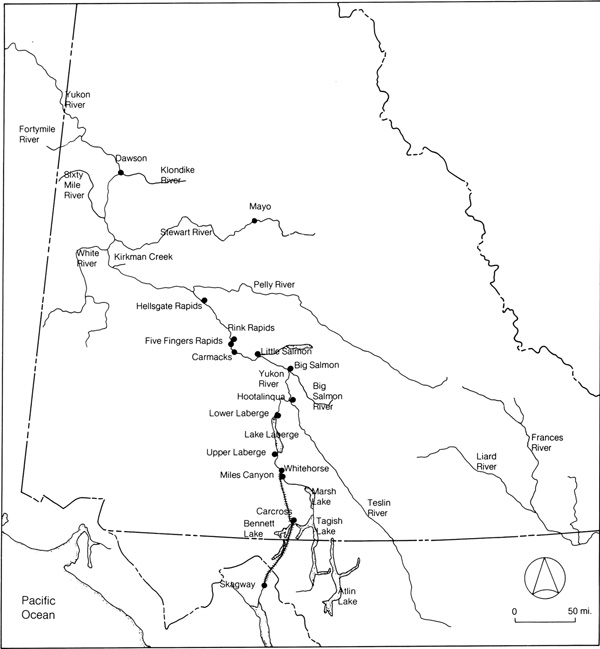
62 Yukon River.
(Map by S. Epps.) (click on image for a PDF version)
|
III
The Yukon River continued to be the most important transportation
artery in the Yukon between 1900 and 1914 just as it had been through
the fur trade, early prospecting and gold-rush phases of Yukon history.
The one significant modification that occurred during this period was
the completion of the White Pass and Yukon Route railway from Skagway to
Whitehorse in July of 1900. With the completion of the railway, a
practical alternative to the lower river route via Saint Michael came
into existence. But the emergence of this alternative did not diminish
the river's role; instead, it enhanced it and gave the river a greater
utility. The river itself remained the heart of the Yukon transportation
system. For this reason, an understanding of its peculiar qualities is a
necessary prerequisite to any examination of the evolution of
transportation in the territory.
The Yukon River, 1,993 miles in length, is the fifth-largest river in
North America.11 Authorities differ as to its exact source,
some designating it as Lindeman Lake, others citing the Nisutlin River
and Summit Lake.12 From its source, the Yukon River follows a
tortuous course to its mouth on the Bering Sea off Norton Sound in
Alaska. For half of its length the river flows in a northwesterly
direction through the central plateau of the Yukon Territory. At the
edge of the Arctic Circle it shifts abruptly to the southwest as if
deflected by the inrushing waters of the Porcupine, and from there it
flows on inexorably to the sea. The peculiar ambulations of the
watercourse — here like a corkscrew, there like the furrows in a
field — are suggestive of the contradictions which characterize
the river itself. Inordinately circuitous and difficult to navigate, the
river nonetheless provides an inland waterway through the heart of
Alaska and the Yukon, the only fissure in an otherwise impregnable land
mass. Long by any standard of measurement, the river is shallow through
most of its extent, the consequence of a semiarid climate. Swift on the
upper section, the river rapidly loses velocity as it spills onto the
Yukon plateau, and from there meanders lazily to the sea.13
Unlike any other river of comparable economic importance, certain
sections of the river on the Canadian side of the international
boundary line have different high-water periods during the year. The
section of the river between Marsh Lake and Fort Selkirk, formerly known
as the Lewes, and the section below White River reach their high-water
marks in July and August, after the solar energy of the summer months
has melted the glacial ice that feeds them. On the other hand, those
sections below the river's snow-fed tributaries, the Teslin, Pelly and
Stewart rivers, have their high-water periods in late spring, after the
annual spring break-up of the ice.14
The railway eliminated the obstacles to navigation at Miles Canyon
and Whitehorse, thereby furnishing the necessary conditions for a
successful challenge by the upper route for sternwheeler traffic on the
Yukon River.15 After 1900 the upper river virtually
superseded the lower river as the primary gateway to the interior and by
1915 its traffic monopoly was practically complete. Despite this
weighting of the balance at the expense of the Saint Michael route,
however, serious impediments to navigation on the upper river between
Whitehorse and Dawson existed. On Lake Laberge, the opening of the
navigation season was delayed each spring while sternwheeler crews
anxiously waited for the ice on the lake to rot and break up, some two
weeks after the ice on the river below the lake had gone
out.16 It was not until the early 1920s that this problem
was overcome and the navigation season prolonged by the successful
damming of the headwaters on the lake. At Five Finger Rapids,
approximately 150 miles below Laberge, four massive knuckles of rock
jutted out the water, ready to smash the sternwheeler whose unwary pilot
had failed to hug the east bank. Below the Five Fingers were the sunken
reefs of the Rink Rapids. At Hellsgate Rapids, just above Fort Selkirk,
the island-studded river appeared to flow in greater volume along the
east bank, but the pilot who failed to use the navigation channel near
the west bank did so at his peril.17 Below Kirkman Creek, a
small tributary that was located above the confluence of the White and
Yukon rivers, deposits of detritus caused the navigation channel to
shift throughout the season. These were the major obstacles to
transportation, apart from the climate, on the upper river and this was
the highway that was to be internal life line of the Yukon Territory
until 1950.
Ownership of the railway placed the White Pass and Yukon Route in an
excellent position to exploit the transportation potential of the
upper river route to Dawson. This potential was recognized as early as
1899 by the directors of the company who had had either the perspicacity
or the good fortune to charter the company as a general transportation
line which included the right to build wharfage and docking
facilities.18 With the collapse of the gold-rush economy and
the resultant withdrawal of most of the transportation companies that
had evolved to meet the demands of the gold-rush population, the way was
cleared for the White Pass and Yukon Route to enter the river
transportation business.
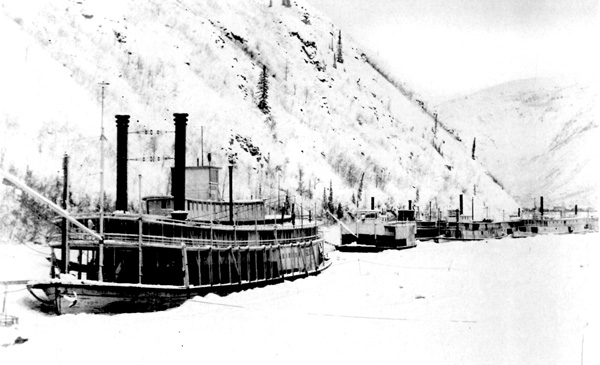
63 Steamers in winter quarters at Dawson. They
were wintered in a slough just above the confluence of the Klondike and
Yukon rivers.
(Yukon Archives.)
|
The decision to set up a river division within the company was
precipitated by the general chaos which prevailed on the river during
1900. As the sole transportation company providing service from
tidewater at Skagway to the head of navigation on the Yukon River at
Whitehorse, all traffic going into and out of the Yukon via the upper
route went by the White Pass and Yukon Route railway. This led to
innumerable problems at the transfer point at Whitehorse where
through shipments of goods were split up, Customs papers lost,
goods stolen on the boats . . . . Many of the boat owners were
not responsible financially, so that the passengers with through
tickets and the goods owners with through bills of lading naturally
preferred to make their claims against us [the White Pass and Yukon
Route], leaving us in our turn to recover from delinquent boat
owners — if we could.19
These difficulties convinced the first president of the company,
S.H. Graves, that in "self-defense we must organize our own river
service."20
The company's plight was not nearly so severe as Graves's statement
would tend to imply. To be sure transhipment mix-ups gave cause for
concern. But the company was also aware that the setting up of a river
division would result in the elimination of any serious competition by
virtue of the company's ownership of the railway. With Tancred's
approval, a river division was subsequently organized and styled the
British Yukon Navigation Company.21 During the winter of
1900-01 the company built a shipyard in Whitehorse and a repair
yard in Dawson.22 Three boats were purchased from the
Canadian Pacific Railway Company, the machinery and fittings from which
were installed in new boats built at the British Yukon Navigation
Company's Whitehorse shipyard.23 On 1 May 1901 the British
Yukon Navigation Company acquired the fleet of its largest potential
competitor, the Canadian Development Company, and shortly thereafter
extended its operations to Atlin, British Columbia.24
The economic vicissitudes of the post-gold-rush period had a serious
impact on the numerous transportation companies plying the Yukon River.
After 1901 most of them withdrew from the field, unable to compete with
the White Pass and Yukon Route's complementary railway and sternwheeler
service. A number managed to sell their boats to the British Yukon
Navigation Company and by 1903 all but three boats on the upper river
were owned by the White Pass subsidiary.25 But though the
post-1900 economy had serious implications for the transportation
companies that had sprung up to serve the demands of the gold rush, it
was of minor consequence for the Yukon transportation system as a whole
and was not without its benefits. The British Yukon Navigation
Company enjoyed a period of relative prosperity between 1901 and 1914
although this prosperity occurred at the expense of competitive
conditions on the upper river. When the conversion to capital-intensive
mining took place after 1903, the transportation legacy of the gold
rush, in the name of the White Pass and Yukon Route, played a vital
role. Without the complementary facilities of the railway and the
post-gold-rush sternwheeler fleet offering through rates from tidewater
to Dawson, the transition to capital-intensive mining would likely have
occurred on a much reduced scale.
By 1907, having pursued an aggressive policy of eliminating common
carrier competition, the British Yukon Navigation Company enjoyed a
monopoly on the upper river limited only by a single independent
company operating one sternwheeler between Whitehorse and Dawson. In the
same year, wharfage rents in Dawson were brought into line with
prevailing conditions by reducing them 50 per cent.26
While transportation on the upper river was adapting itself to the
changing transportation requirements of the territory and exhibiting a
visible trend toward monopoly, a similar process of adaptation was
occurring on the river below Dawson. Before 1901 the lower river had
been the principal supply route to the Klondike gold fields. After the
completion of the railway, however, Skagway replaced Saint Michael as
the main port of entry to the Yukon. The impact of the railway coupled
with the collapse of the gold-rush boom were such that no
transportation company on the lower river showed a profit for its
operations during the 1901 navigation season.27
To strengthen the competitive position of the Saint Michael route and
to offset the depression that hit the transportation industry on the
lower river after 1900, the Alaska Commercial Company, theretofore the
largest trading and transportation company in the Yukon and Alaska,
merged with the International Marine Company and Alaska Goldfields in
1901. The new firm's merchandizing and transportation operations were
then separated into two distinct companies, the Northern Commercial
Company and the Northern Navigation Company. Shortly thereafter the
Northern Navigation Company bought out the Seattle-Yukon Transportation
Company. In 1906 the North American Transportation and Trading Company,
the second-oldest company in the Yukon, sold its sternwheelers and Saint
Michael terminal to the Merchants-Yukon Transportation
Company.28
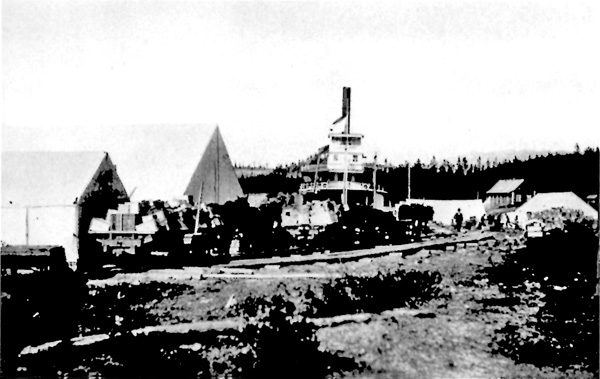
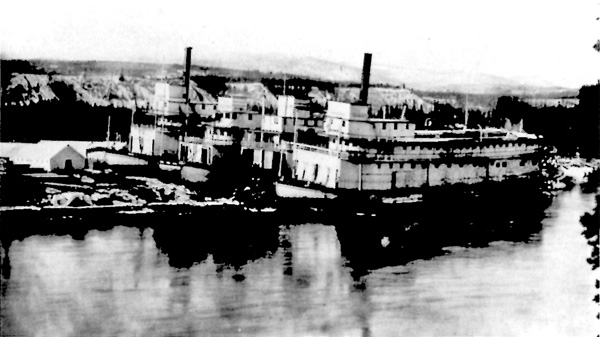
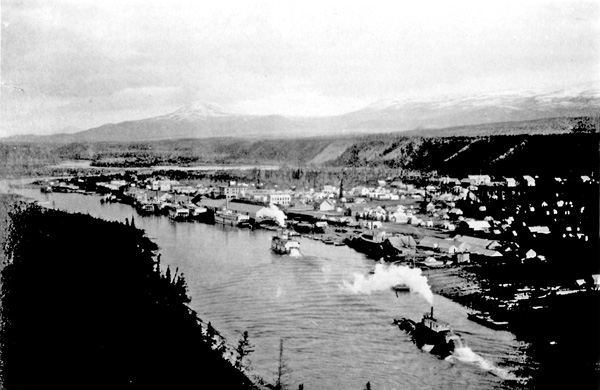
64-66 The evolution of Whitehorse's waterfront, 1899 to 1901.
The shipyard is on the right in Figure 66.
(Yukon Archives.)
|

67 The Alaska Commercial Company (later Northern Navigation
Company) steamers Sarah and Susie tied up at
Saint Michael.
(Yukon Archives.)
|
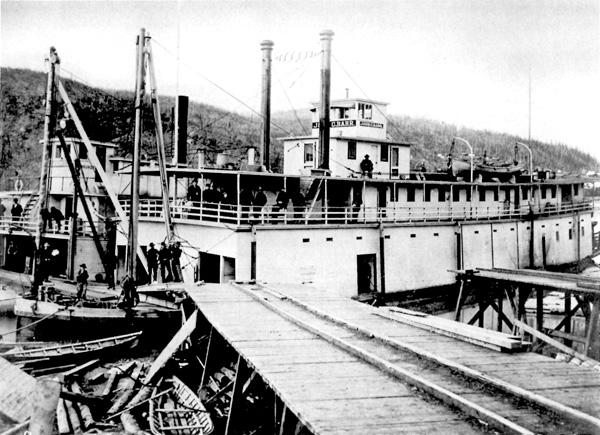
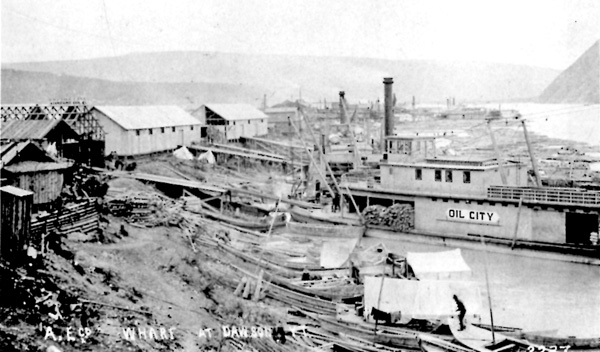
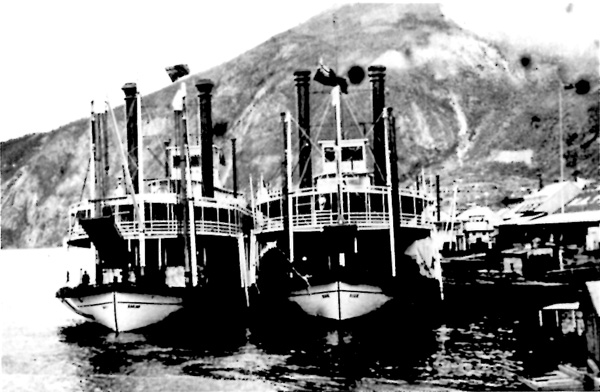
68-70 Typical lower river steamers. Not only size distinguished
the gold-rush boats on the lower river from those of the upper
Yukon. Twin stacks were fairly common on the former, absent on
the latter. The pilot house was usually located further aft on
the lower river boats and on some of the larger ones the
gangway, or swinging stage, was carried toward suspended from a
boom rather than on the for'deck as on most upper river vessels.
Portions of the main deck were often open on the former, almost
always completely enclosed on the latter. Lower river vessels
were more ornamental and resembled sternwheelers typical of
the American Midwest, whereas the boats on the upper river were
similar to river boats of British Columbia, Oregon, and
Washington state.
(Yukon Archives.)
|
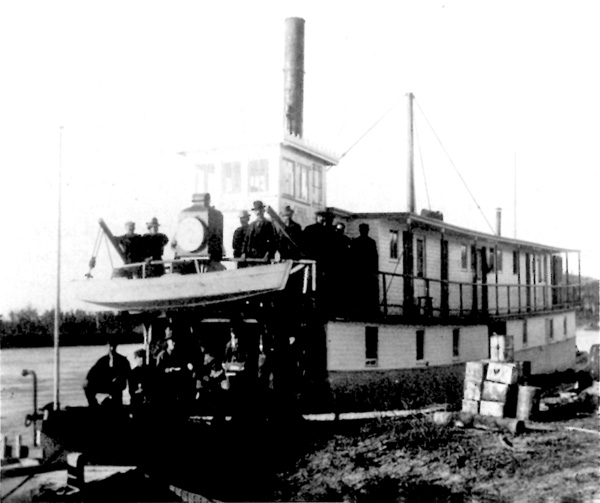
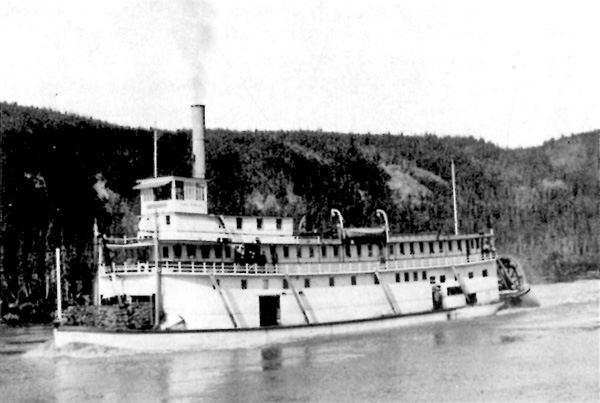
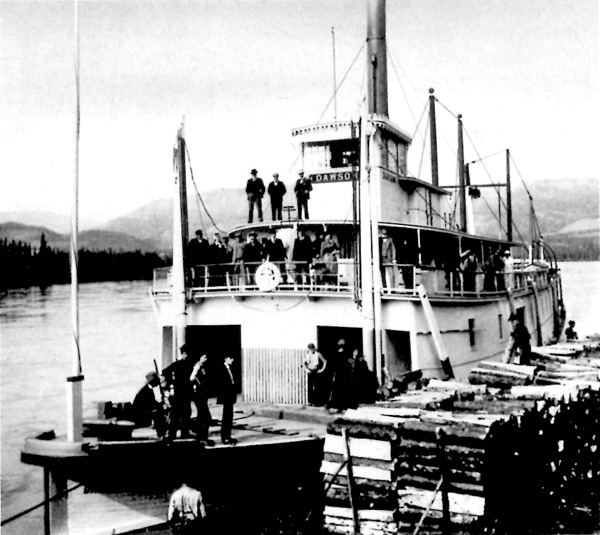

71-74 Typical upper river boats. The Flora (Fig. 71)
was built at Bennett in 1898 for the Bennett Lake and
Klondike Navigation Company by Bert Fowler, who later became
shipyard foreman for the British Yukon Navigation Company.
The Columbian (Fig. 72) was built at Victoria in 1898
by John Todd, who built a number of vessels for the Yukon
River. The Dawson and Selkirk were built by
the British Yukon Navigation Company in 1901 at Whitehorse.
(Yukon Archives.)
|
The elimination of competition through merger prolonged the life of
the Saint Michael route. As well, the lower river possessed certain
competitive advantages which, if not sufficient to turn the tide of
Yukon trade away from the upper route, at least deferred
the lower river's demise. To begin with, larger boats could be used
on the lower river. Second, in supplying Fairbanks, lower-river
companies effectively cut the length of their supply lines to Dawson by
half. Third, some of the largest stores in Dawson were owned by
transportation companies on the lower river whereas the White Pass and
Yukon Route had no merchandizing outlets.29 Finally, the
"exorbitant" freight rates charged by the White Pass and Yukon Route
alienated many Dawson merchants. As one of them declaimed, "look into
Lower R[iver] shipping, the less we ship White Pass, the better for
us."30 But the repeal in 1904 of the law that had previously
permitted the free shipment of Canadian goods from a Canadian port to
Dawson via Saint Michael came as a serious blow to the transportation
companies on the lower river.31
By 1912 business in the Yukon had contracted sufficiently to
precipitate an open fight between the upper and lower river for the
right to supply Dawson. The contestants were, appropriately enough, the
Northern Navigation Company and the British Yukon Navigation Company.
Much to the delight of the residents of Dawson, the first round in the
contest was a rate war. The British Yukon Navigation Company then
carried the fight into Alaska by putting two of their vessels, the
Alaska and the Yukon, on the lower river to connect with
Fairbanks. The Northern Navigation Company retaliated "by contracting
on a continuous basis with heavy shippers for freight to be shipped via
St. Michael." The prospect of mutual bankruptcy finally drove both
companies to the bargaining table and on 10 April 1914 it was announced
that the White Pass and Yukon Route, acting for its wholly owned
subsidiary, the British Yukon Navigation Company, had purchased the
entire river operation of the Northern Navigation Company.32
By 1914 the upper route had established hegemony on the Yukon River.
Although water transportation was primarily confined to the Yukon
River during this period, there was some activity on the tributary
streams. One of the more interesting features of this activity was the
role played by government in diverting attention from the main
watercourse to the tributaries through a policy of direct involvement
in river navigation. Behind this policy was an attempt to diversify and
decentralize the economy of the territory by opening up new areas for
exploitation. In 1906 the Canadian government assisted prospectors going
into the Pelly region by giving them free passage on Royal North-West
Mounted Police steamers. This policy was expanded in 1907 when the
commissioner of the territory announced that the government was
prepared to subsidize transportation companies making trips up the Pelly
and Stewart rivers. Although the subsidies were discontinued after 1908,
they achieved the desired effect and by 1909 light-draft steamers
were operating on the Stewart, Pelly and Hootalinqua rivers. In 1909 as
well, the Side Streams Navigation Company was formed. This company
operated a small sternwheeler that supplied the White, Stewart and Pelly
rivers and the Fortymile River up to the canyon.33 While the
opening up to navigation of the tributaries of the Yukon River did not
result in the discovery of any new large mineral deposits, the side
streams trade was an important addition to the meagre transportation
facilities that had previously served the small communities on these
tributaries.
The sternwheeler underwent certain modifications in design and
engineering following the establishment of the British Yukon Navigation
Company. In large measure this was because the physical characteristics
of the upper river required boats of shallower draft and narrower beam
than those that operated below Dawson. This requirement was not unique
to the Yukon River; it obtained on virtually every major waterway in
Canada and in the United States as steamboat service was extended
upriver. Nor was it as dramatic as the change that had occurred on the
Mississippi where the sternwheeler replaced the sidewheeler as traffic
moved upstream. Outside of one reference which has never been verified,
there is no record of sidewheelers having ever operated on the Yukon.
Thus the evolution that took place on the Yukon was one of degree, not
kind. The development of the Yukon steamboat paralleled the development
of boats on rivers west of and tributary to the Mississippi —
rivers that were narrower and shallower than the Mississippi. Considered
as a prototype, the sternwheeler was more suitable to these smaller
waterways since its rear-mounted paddlewheel and relatively
flat-bottomed hull were conducive to operating in shallow water and the
absence of sidewheels gave it a narrower beam than the lower Mississippi
steamer and hence the ability to negotiate narrower channels. The
stern-mounted wheel provided other advantages as well: it gave grounded
steamers an opportunity to wash away sand from the hull by reversing
engines; it was protected by the hull from snags and sweepers, and
because it was designed for low water, it permitted the sternwheeler to
land virtually anywhere along a riverbank without special docking
facilities.
The sternwheelers that were built by the British Yukon Navigation
Company were patterned after the "swift water" boats that operated on
the Snake, Willamette and Upper Columbia rivers, rivers that more
closely approximated travelling conditions on the upper
Yukon.34 They were designed to carry heavy cargoes downstream
on a very light draft and to make the return trip upstream with light
freight and fuel with the paddle wheel still "sufficiently immersed to
take up the power of the engines without racing." This was accomplished
by providing the boats with tremendous backing power so that sharp
turns, narrow channels and swift currents could be negotiated without
having to depend on the rudder alone. This backing power was not only
used to reduce the speed of the boats on downstream trips, but to aid in
steering as well.
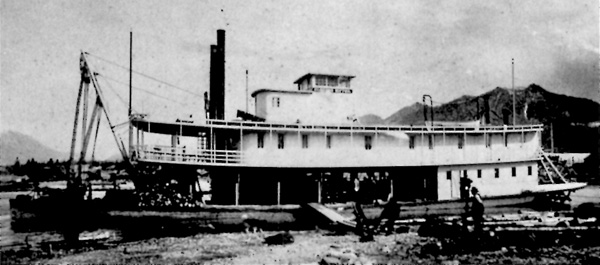
75 Although it was built at Bennett, operated on the upper river and
named for Canada's minister of the Interior, the Clifford Sifton
was not a typical upper river boat. It had much in common with the lower
river genre, an anomaly explained by it having been built and owned by
a Kansas syndicate.
(Yukon Archives.)
|

76 Known affectionately as the "Old Gray Mare," the steamer
Whitehorse plied the Yukon River for 53 years —
longer than any other boat in the northern fleet. Built in 1901
and rebuilt in 1930, it operated until 1953. It was destroyed
by fire in 1974.
(Yukon Archives.)
|
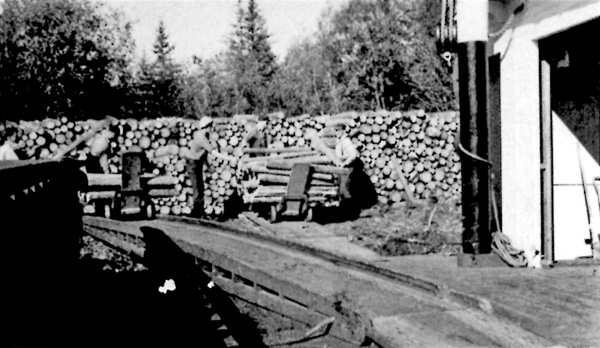
77 Loading fuel onto the for'deck and into the freight house of
a sternwheeler. Deckhands were on call 24 hours a day to perform
this task. The hand trucks held approximately one-third of a
cord of wood.
(Photo by B. Lesyk.)
|
To compensate for the "slide" of a single rudder, the company devised
a system utilizing six rudders, three behind the paddle wheel and three
between the wheel and the hull, that were controlled by a steam steering
gear. This system permitted the efficient use of the steering apparatus
whether the boat was going backward or forward. As a result, the
steering of these vessels did not depend "as in other craft, on having
steerage way; but on the movements of the stern
paddle-wheel."35
While the boats used by the British Yukon Navigation Company differed
in size and capacity during this era, they did not, in most cases,
exceed 170 feet in length or 35 feet in width. The larger ones carried
between 200 and 250 tons of cargo on a draft of 4 feet. When empty they
drew approximately 18 inches. On the downstream run they averaged 15
miles per hour, covering the distance between Whitehorse and Dawson in
two days. The upstream voyage took four days. The boats had electric
generators and were provided with spot beams to permit night travel
during the period following break-up and just before freeze-up. The
beams were only used on the upstream trip, however, because the swift
current on the downstream run made night travel too hazardous. During
the summer when darkness was not a problem, the boats were in operation
24 hours a day. Freight was carried on the main deck for ease of
handling, with the result that the main deck came to be known as the
"freight house." The engine room and boiler were also located on the
main deck, in the stern and bow respectively.36
These boats carried up to 150 passengers who were accommodated on the
observation and upper decks. Passenger compartments were called
staterooms, a term that originated with the Mississippi steamboats where
the custom had been to paint the names of various states over the door
to each room. Accommodation on the upper deck was generally of a higher
quality than that of the observation deck and the term "Texas," which
also derived from the Mississippi, was used to designate it. Above the
Texas deck was the pilot house. Each boat was provided with a dining
room and liquor was served.37
The British Yukon Navigation Company sternwheelers burned wood for
fuel. On the downstream trip only a limited quantity of fuel was
required for "backing" and steerage. Upstream these vessels consumed
between one and one-half and two cords of wood per hour. Each fall, wood
contracts were let to various individuals living along the riverbank who
cut and stacked timber at regular intervals on the sternwheeler route
for use the following summer. In 1904 the company conducted experiments
with local coal, but its quality was not high enough to justify
converting the sternwheelers into coal burners.38
Despite the many innovations in sternwheeler technology that occurred
as a result of the formation of the British Yukon Navigation Company,
certain characteristics of the Yukon River continued to plague
navigation. Shifting channels, bars and reefs did not disappear with
modifications in the technology of the sternwheeler and efficient
operations continued to demand experienced boatmen and pilots who were
adept at "reading the water" — recognizing the shifting channels
and other impediments to navigation by breaks in the surface and by the
colouring of the water.39 Several techniques were developed
in order to assist the movement of the sternwheelers through difficult
sections and several improvements were made to the river itself.
Of the former the most generally employed was a modification of the
"tracking" technique known as "lining." To track a boat, a number of
men, proportional to the weight of the boat and the strength of the
current, walked along the bank with ropes or track lines, moving the
boat by pulling these ropes in the desired direction.40
Lining a boat followed the same principle, but applied machinery to the
task instead of muscle. When a sternwheeler reached a section of the
river where lining was necessary, a row boat with a flexible cable was
despatched to a point where the cable could be made fast. (Later,
permanent cables were installed where necessary.) If a well-embedded
tree were not available, a "deadman," or heavy log, was set. With one
end of the cable attached to the deadman and the other end tied to the
steam capstan on the boat, the sternwheeler hauled itself through on the
cable. When additional power was required, a "strop" was put on the
cable and a "purchase tackle" was attached to the capstan, a procedure
that had the effect of increasing the power of the capstan from two- to
fourfold.41
Because of the shallow water and shifting channels, sternwheelers
often went aground. When this occurred the backing powers of the paddle
wheel were utilized in an attempt to wash away the bar. If this tactic
were unsuccessful, resort was made to lining or "sparring." Each boat
was equipped with two spars, the ends of which were placed under the
hull of the boat, one on each side when sparring was required. Once set,
the spars were held in position by swinging derricks. Atop each spar was
fastened a three-sheave block held in place by a heavy wire strop, while
corresponding blocks were made fast to the port and starboard sides of
the ship. Tackle ropes were then run from the spars to the steam capstan
on the fo'c'sle. As the capstan drew the ropes, most of the boat's
weight was transferred to the spars. This done, the engines were started
and the boat lurched ahead "like a sick grasshopper," the procedure
being repeated until the boat was off the bar.42
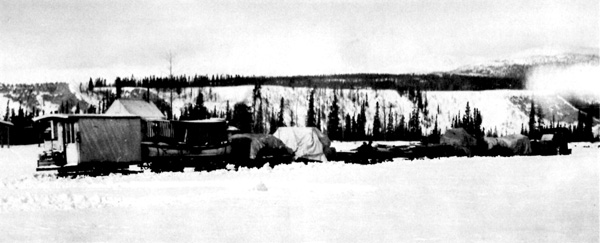
78 Hauling supplies over the ice on Lake Laberge in the spring
for transhipment by boat to Dawson. For many years the British
Yukon Navigation Company wintered a boat at Lower Laberge to
take advantage of the fact that the river below Laberge opened
two or three weeks earlier than the lake.
(Yukon Archives.)
|
With the conversion to capital-intensive mining, the building of the
Klondike Mines Railway and the displacement of the lower river by the
upper route, new methods of heavy freight transport were developed to
handle machinery that could not be loaded onto the deck of a
sternwheeler. Beginning in 1903, scow-assisted sternwheeler transport
became extensive, only to be replaced the following year by small
barges. Large barges were introduced in 1905 and served to increase
carrying capacity to some 450 tons during high water. After that the
pushing of barges became an integral part of the movement of freight on
the Yukon River. Given the river's shallow and crooked nature, this
necessitated the use of "jackknifing" in order to negotiate sharp
turns. To jackknife a boat through a turn, the barge was angled over the
shallows while the sternwheeler was kept in the
channel.43
Another practice adopted by the company, in this instance to extend
the navigation season, was to winter a sternwheeler at the foot of Lake
Laberge. The ice on the river below Laberge broke up before the ice on
the lake went out and wintering a vessel at the foot of the lake added
about two weeks to the short navigation season. Employing men to look
after the sternwheeler during the winter months increased the costs of
an otherwise seasonal operation and the charges incurred by the cartage
of freight over the ice of the lake to supply the sternwheeler offset
many of the advantages that were gained by extending the navigation
season.44
The feud between transportation and the river was not an entirely
one-sided contest. The river, too, was forced to concede some of its
natural superiority as men sought ways to make it more amenable to the
movement of traffic. Between 1900 and 1914 the government sponsored a
series of river improvements — at times independently and at other
times in league with the navigation companies operating between
Whitehorse and Dawson — to eliminate the most difficult obstacles
to navigation on the upper route.
One of the first of these improvements was the construction of a
breakwater by the Department of Public Works at the head of Lake Laberge
in 1899-1900. The breakwater proved inadequate, however, when in
1902 the ice carried a portion of it away and the channel reverted to
its old course.45 This section continued to be a problem
requiring annual work until the British Yukon Navigation Company built
a dam at Marsh Lake in the early 1920s.
In 1900 a portion of the rock outcropping at Five Fingers was blasted
in order to widen the east channel. Two years before, the stampeders had
installed a windlass there to line their boats through, an improvement
that had its limitations since it was restricted to use by small scows.
In 1904 a cable was laid through the Five Fingers to assist
sternwheelers on the upstream run. For years the Department of Public
Works worked on the Five Fingers, dynamiting the rock formation until
the channel was widened by some 20 feet.46
In 1900 one official reported that "during low water heavily loaded
steamboats touch the bottom of the river" at Hellsgate. In 1902 the
government built a dam there to deepen the channel. By
1908 the dam had deteriorated to such a degree that it was necessary
to refill it and improve the breakwater.47 In the same year,
the British Yukon Navigation Company expended a government appropriation
of one hundred thousand dollars removing the rock and reef obstructions
at Rink Rapids.48
Taken together, the innovations in sternwheeler technology, the
utilization of a variety of navigational techniques and the river
improvements greatly reinforced the vital role played by the
sternwheeler in the economy of the territory between 1901 and 1914, a role
that had had its awkward beginnings as early as 1866 and was to last
until 1950.
Like the mining industry to which it was so closely tied, river
navigation underwent a painful period of readjustment during the first
14 years of the century. When the gold rush ended, most of the river
transport companies on the upper river ceased operation, but the
collapse of the gold-rush economy did not herald the end of the
sternwheeler, A new company emerged which for the first time had come to
the Yukon to stay.49 The effects of this commitment were
far-reaching. For the first time boats were built in the Yukon and the
sternwheeler was adapted to suit the limitations of the river.
Carpenters, engineers and crews, if only in small numbers, were given
employment where before there had been none. The investment of the White
Pass and Yukon Route in its transportation facilities meant that the
company had a practical interest in the economic development of the
territory that was not simply restricted to the high-grading type of
exploitation that had prevailed before. Finally, the company's
commitment gave to the Yukon a degree of stability and assurance unknown
during the gold rush.
The sternwheeler was more than a carrier of men and supplies into and
out of the territory, It was an active participant in the mining
conversion. It supported the timber industry by burning wood for fuel
and united the small communities that hugged the riverbank. By 1914 it
was an integral element in the life style of every Yukoner.
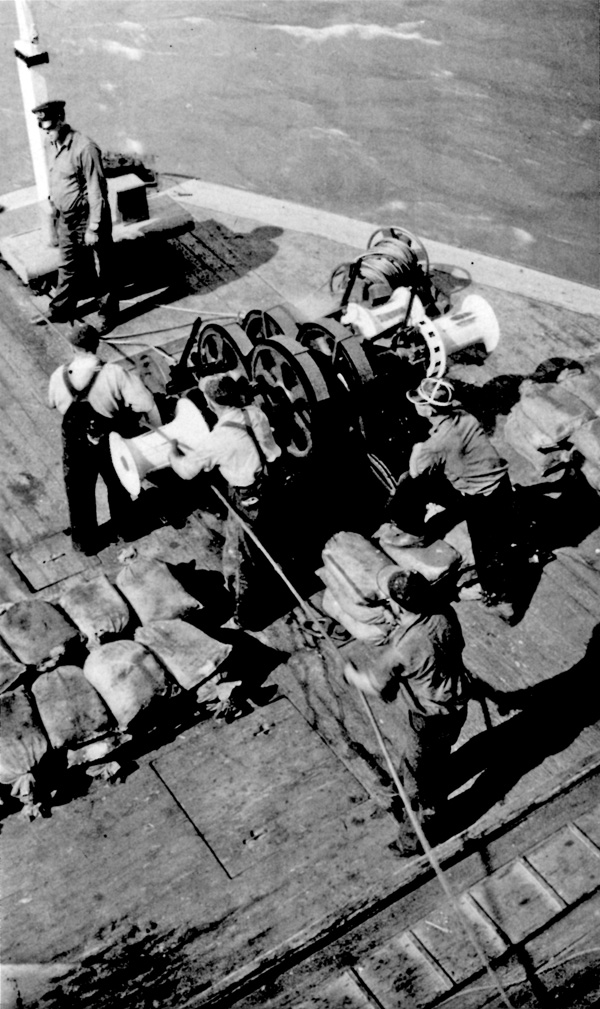
79 SS Klondike No. 2 lining through Five Finger Rapids.
The cable was picked up with a pole and wrapped around the winch
drum. Power was then applied and the boat pulled itself through.
(Photo by B. Lesyk.)
|
IV
From the day it was completed, the Skagway-Whitehorse railway proved
to be a remarkably profitable enterprise. One contemporary alleged that
the entire cost of construction was liquidated during the company's
first year of operation. In 1901 and 1904, two years for which figures
are available, the company's net earnings were $1,500,000 and $451,000
respectively. Until 1912 the White Pass and Yukon Route returned a
dividend at the end of each fiscal year to its investors, a return that
reflected the intensive utilization of the railroad's facilities.
Through 1911 as many as three trains a day, except Sunday, were run
between Skagway and Whitehorse during the summer months, while in the
winter, when the river was closed to navigation, there still existed
sufficient demand for the company to operate an average of six trains a
week.50
The Yukon winter provided the railway with its severest test during
these years. Each November the annual struggle between the railway and
the elements commenced, a struggle which lasted until April of the
following year. And every year the winter extracted its toll from
roadbed, rolling stock and train crews. No other railway on the
continent pushed through such extremes of winter climate in 110 miles.
From Skagway to Bennett high winds and heavy snows prevailed. On the
section between Glacier and Bennett the snow depth often reached 25 feet
and severe winds frequently drifted it 25 more. From Bennett to
Whitehorse the snowfall decreased as temperatures plunged, sometimes
reaching 60 degrees below zero. In the spring, snow slides and washouts
wreaked havoc with the safe movement of passengers and freight and
demanded the engineers' constant vigilance. To deal with these
conditions, the company maintained two rotary snow-plows and erected a
series of massive snow fences on the Canadian side of the summit to
keep the line clear, but even these precautions did not eliminate the
need to use train crews armed with no more than shovels to free the
tracks after a particularly heavy snowfall.51
Apart from its "life line" function to the Yukon interior, the White
Pass and Yukon Route exploited to advantage one of the two new resources
that were discovered during this period. The first comprised the summer
tourist trade, a trade that was to increase significantly over the
years, becoming a mainstay of the railway during the desperate years of
the 1930s. The lure of the Klondike was still powerful during this
period, as the popularity of books on the gold rush demonstrated, and,
moreover, was more than matched by the spectacular scenery that ringed
both sides of the rail line between Skagway and Whitehorse and
highlighted the sternwheeler excursions operated by the company to
Atlin, British Columbia. Arrangements were made with the coastal
steamship companies operating into Skagway to exploit this colourful
history and splendid scenery. On the two-day stopovers at Skagway made
by Canadian Pacific Railway steamers, the White Pass and Yukon Route ran
tourist excursions into the interior, while on the one-day stopovers
scheduled by the Alaska Steamship Company and the Pacific Steamship
Company, the White Pass and Yukon Route operated special return-trip
excursions to Bennett Lake.52
The second resource to be exploited was the copper deposits
contiguous to Whitehorse. As early as 1897 several outcroppings of
copper had been reported by prospectors stampeding to the Klondike and
in 1898 the first claim was staked. For the next nine years exploratory
work and occasional shipments of copper ore were made, but poor
transportation facilities based on a wholly inadequate road system
pushed costs to prohibitive levels. In 1907 production was increased
substantially, reaching a level of 3,530 tons. In the same year the
White Pass and Yukon Route decided to build a spur line from MacCrea,
seven miles south of Whitehorse, to the Valerie, Arctic Chief, Grafter,
Best Chance, Spring Creek, Pueblo, War Eagle, Copper King, Rabbit's Foot
and Anaconda copper properties. Construction was begun in 1907 and
continued through 1908. A sharp decline in production in 1908 followed
by the cessation of production in 1909 resulted in a construction
stoppage for 16 months. The failure of these mines during 1908-09 has
been attributed by one writer to "the high freight rates charged by the
White Pass and Yukon Route railway and the inadequacy of transportation
facilities between the mines and Whitehorse."53
Work resumed on the 12-mile spur line in 1910 and the final four
miles were completed to the Pueblo property in August. Beginning in
1911, daily ore trains were operated on a year-round basis. A reduction
in the White Pass and Yukon Route freight schedules in 1912 was a
significant factor in bringing the mines back into production.
Production increased at a rapid rate during World War I following a rise
in the world price of copper, but the cessation of hostilities depressed
the price of copper, and brought into focus once more the delicate
balance between transportation and profitable mineral production in the
Yukon. Like the gold rush, the First World War camouflaged the basic
problems that underlined the Yukon economy. Inflation and increased
demand more than compensated for the high costs of production and
transportation over the short term. Yet the gold rush and the war were
events of short duration and once the specific demands they had
engendered disappeared and normality returned, the cost-price dilemma
reappeared in high relief. After the war, copper production practically
ceased and the spur line was abandoned.54
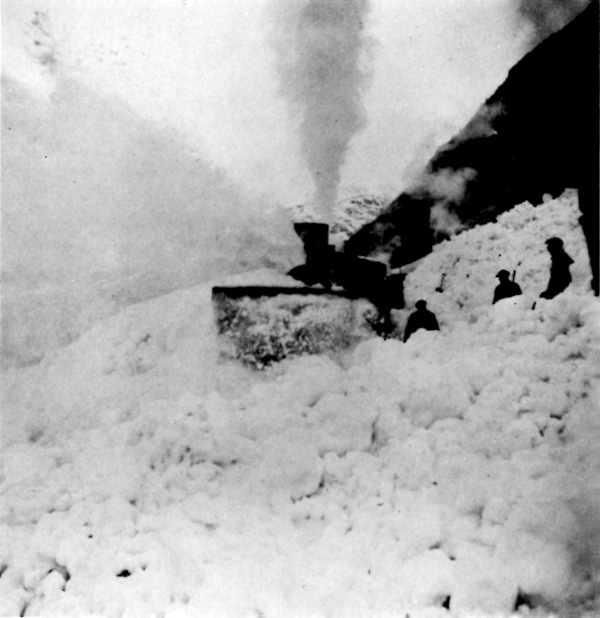
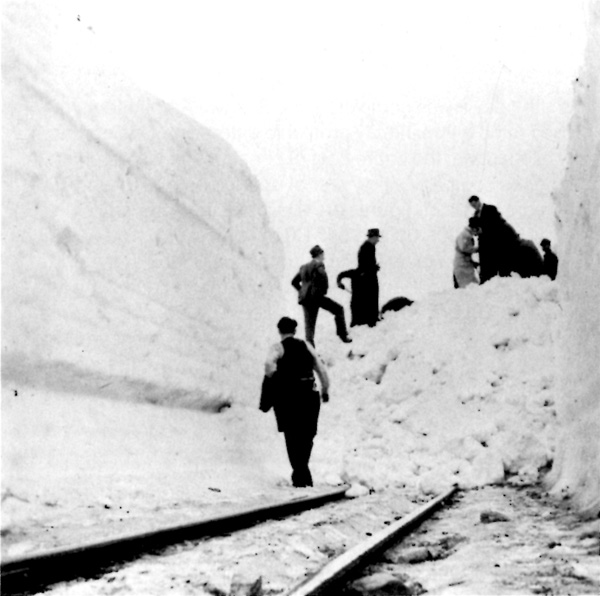
80-81 Men and machinery battle snow on the White Pass and Yukon
Route.
(Photos by J. Dunn.)
|
The adverse effect of transportation costs on the successful pursuit
of enterprise in the Yukon was not restricted to the nascent copper
industry. The experience in the Klondike district, while different in
one essential respect from that of the Whitehorse copper mines,
reflected the same basic transportation problems. What distinguished the
former from the latter was not the nature of the transportation burden,
but its distribution. In the latter case, transportation costs had been
borne directly by the copper industry as a result of a small,
producer-oriented population and the bulk characteristics of the mineral
produced. In the Klondike the transportation costs were borne by the
entire community. The reason for this was simple. In the case of
copper, the standard of value was price per ton, while with gold, value
was measured in ounces. Whereas in the copper industry the
transportation costs were borne by the outgoing traffic, in the Klondike the
transportation costs were borne by the incoming traffic and as a
consequence, the whole community was affected — producers, by
virtue of the need to pay higher wages in order to compensate for the
higher cost of living, and consumers, who covered the transportation
charges in the price they paid for each product they
purchased.55
Grievances, real and imagined, against the schedule of freight rates
published by the White Pass and Yukon Route were a constant refrain
during this period — and indeed have remained so to the present
day. The railway did not effect a massive reduction in transportation
costs; rather it made transportation faster, easier and more
reliable.56 Apart from the criticism of tariff schedules that
sprang from legitimate complaints, the White Pass and Yukon Route's
virtual monopoly on traffic into the interior made the company more
vulnerable to attack than would have been the case had competitive
conditions prevailed.
After the collapse of the gold-rush economy, the population of the
Klondike district declined. This decline was followed, in turn, by a
corresponding decline in business. "As a result... attempts were made to
reduce costs and particularly costs of transportation." There followed a
period of agitation for a reduction in the freight rates charged by the
White Pass and Yukon Route. As early as 1901, the company was ordered to
lower its rates by the dominion government. Continued economic
contraction after 1901, however, offset the immediate benefits of the
reduction and attacks on the company's rates increased in intensity.
In 1905 the Dawson Board of Trade argued that the future of the
territory depended on transportation costs being low enough to work
profitably the remaining low-yield gravels and it condemned the White
Pass and Yukon Route for its "extremely exorbitant freight and passenger
rates [which it is able to charge] by reason of an unjust monopoly . . .
[thereby] injuring the entire business interests, [and] hampering and
retarding the . . . development of . . . mining." Citing evidence that
three-eighths of the territory's production was consumed by
transportation costs, the board demanded that the company either be
ordered to halve its existing rate schedule or that the government
subsidize a competing line. This resolution attracted the support of the
Young Men's Liberal Club in Dawson and the commissioner of the
territory.57 Yet despite this widespread support for the
Board of Trade recommendations, the resolution was not acted upon by
Ottawa.
An indication of the exorbitant tariff charged by the White Pass and
Yukon Route is suggested by a comparison of various commodity costs and
the freight rates charged for the transport of these items between
Skagway and Whitehorse in 1910. In several instances the freight rates
exceeded the wholesale cost of the product. The high tariff schedule can
be partially explained as owing to the remoteness of the territory from
the major centres of supply. Nevertheless, it is also true that the
directors of the White Pass and Yukon Route recognized that the days of
the "fast buck" in the Yukon were over and they followed a conscious
policy of "getting all that they could, while the getting was good." The
shareholders extracted every last possible profit from the operation,
oblivious to the needs of the Yukon and to the detriment of the physical
facilities of the railway. In two actions against the company, management
was charged with corruption. Finally, in 1911 the Board of Railway
Commissioners ordered the White Pass and Yukon Route to reduce its
freight rates by one-third.58 An appeal to the Privy Council
instigated by the company, however, resulted in the granting of a new
hearing. At the rehearing the board reversed its first decision and
instructed the White Pass and Yukon Route to make a voluntary rate
reduction.59 The company accepted this order and lowered its
rates approximately ten per cent.60
Reaction to the reversal of the board's first judgement was swift
within the territory. George Black, the commissioner, wrote that the
reversal "has not had a tendency to encourage prospecting in the
territory" and emphasized that the question of transportation costs,
with special reference to the White Pass and Yukon Route, was "a matter
of the utmost importance to all persons prospecting and mining in the
Yukon; in fact, to all inhabitants of the territory, as all lines of
business are absolutely dependent on mining."61
V
Transportation in the Klondike district, based as it was on the
horse, the dog and a hodge-podge network of poor roads and trails,
seemed wholly inadequate to handle the traffic requirements of the
region after 1901.62 The conversion to capital-intensive extractive
techniques and the eruption of a number of communities on the
gold-bearing creeks created the need for a form of transportation —
more reliable on the one hand and more capable of moving heavy freight
and machinery on the other — to satisfy the changing
transportation requirements of the district. As had previously been the
case on the Panhandle access route to the territory, the solution to the
problem of traffic movements was found in the construction of a
railway.
As early as 1897-98, serious consideration had been given to a
proposal to build a railway connecting Dawson with the communities that
were springing up on the placer creeks. In July of 1899, this proposal
was acted upon and the Klondike Mines Railway Company, with its head
office in Ottawa, was incorporated. Under the terms of the act of
incorporation, the railway was to originate in Klondike City, across the
Klondike River from Dawson, skirt Bonanza and Dominion creeks to Indian
River and return to Dawson via the east bank of the Yukon River. Between
1899 and 1903, when construction actually began, the location of the
line underwent several changes. The "loop concept" established by the
act of incorporation was superseded by another plan to locate the
railway from Klondike City to the headwaters of the Stewart River a
distance of some 85 miles, a plan that was superseded in turn by the
promoters' decision to run the line from Klondike City to Sulphur
Springs.63
The elimination of Dawson from the promoters' plans elicited a
variety of protests from that quarter. William Ogilvie, in a letter to
the minister of the Interior, expressed incredulity at the selection of
Klondike City rather than Dawson as the terminus, citing the former's
poor steamboat landing, absence of wharfage and warehouse facilities
and lack of good land suitable for development and expansion purposes as
reasons why Klondike City should not be chosen. Why Klondike City was
chosen over Dawson can probably best be explained by noting that one of
the promoters, Thomas O'Brien, owned a substantial amount of property
there. O'Brien, moreover, had already demonstrated a facility for using
transportation projects as a means to fast money, as the Pioneer Tramway
Company debacle clearly showed. One of the most colourful figures of
the Klondike's first decade, O'Brien was the proprietor of a brewery
in addition to his other interests and he played
an active role in the political squabbles of the period, oddly enough as
a reformer.64
As protests over the terminus mounted in 1902, the promoters of the
railway — O'Brien, W.W. Parsons and E.C. Hawkins — agreed to
appear before the Dawson city council. As a result of this meeting, the
promoters were persuaded to designate Dawson as the terminus and a
franchise was conferred on the Klondike Mines Railway Company for the
laying of track and the building of a station on Front Street in
Dawson.
The series of miscalculations, beginning with the locational and
terminal difficulties which had taken four years to sort out, continued
into 1903 when for the first time a considerable amount of grading was
done and four miles of track were laid and subsequently abandoned. By
September of 1905, however, the first of two sections of bridge over the
Klondike River was completed and work was well advanced on the second.
Then a new problem, this time over the right of way, appeared.
Injunctions obtained by the claim owners on Bonanza Creek forced the
company to abandon construction on that section. The fear, previously
expressed as early as 1901, that the right of way of the rail line would
interfere with a large number of working claims, had materialized.
Mindful of the crisis that now existed, the federal government
despatched a representative of the railway commission to make a full
investigation into the matter.65
Once the controversy over the right of way had been sorted out, the
railway was quickly completed. Three locomotives were purchased from the
White Pass and Yukon Route and by November 1906, trains were operating
on the 31-mile line between Dawson and Sulphur Springs via Grand Forks.
The total construction cost of the narrow-gauge railway was estimated at
two million dollars. Under the terms of an agreement signed on 25 May
1906 the Klondike Railway qualified for a government
subsidy.66
After the railway was completed, the horse-drawn stages that had
previously run between Dawson and Grand Forks were discontinued. Service
to the creeks tributary to the rail line was provided by daily passenger
stages and freight wagons operated by the railway company.

82 The steamboat landing at Klondike City, steamers Lightning
and Tyrrell in the foreground.
(Yukon Archives.)
|
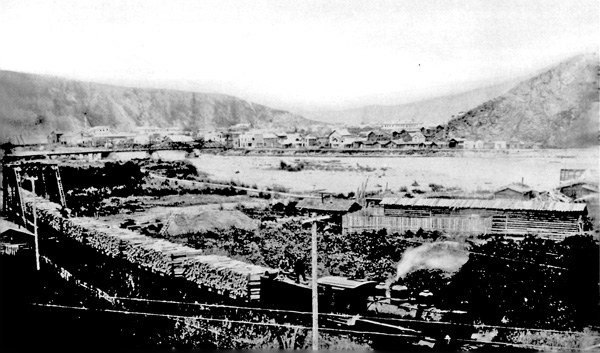
83 A Klondike Mines Railway train en route to the creeks with a
load of timber. Dawson is in the background.
(Public Archives of Canada.)
|
Unlike the White Pass and Yukon Route railway, the Klondike Mines
Railway encountered severe financial difficulties from the very
beginning. After 1906-07 the company abandoned winter operations for
reasons of economy. In 1909 the directors reported that expenditures
exceeded revenues by 100 per cent and petitioned the territorial council
for financial aid. The council responded by granting assistance for a
period of two years. Nevertheless, it was apparent by 1909 that placer
mining could not sustain the railway much longer and, as the general
manager of the Klondike Mines Railway Company put it, "the future of the
railway hinge[s] on [the] development of quartz mining." But quartz
mining never progressed beyond the optimistic appraisals that were made
for it and by 1913 the railway's operations were curtailed to the
12-mile section between Dawson and Grand Forks. Finally, in July of
1914, the company abandoned operations completely.67
An analysis of the failure of the Klondike Mines Railway underlines
one of the many problems involved in any study of the Yukon.
Superficially, the company's failure could be attributed to the economic
decline that characterized the period from 1900 to 1914. However,
assuming the promoters felt (as they must have) that the railway could
make a profit, even as late as 1904 when construction could have been
abandoned, and taking into account the fact that between 1907 and 1914
gold production exhibited a moderate but uninterrupted upswing, it seems
clear that the reasons for the failure of the Klondike Mines Railway
Company are not to be found in declining gold production but rather in
the nature of gold mining itself.68 The conversion to
capital-intensive mining which the railway facilitated reduced the need
for transportation of the type provided by a railway. The railway relied
upon continuous, revenue-producing operation in order to show a profit
whereas capital-intensive placer mining in the Klondike required rail
service on an irregular basis. The conversion to machine-orientated
mining, moreover, was concentrated in an area adjacent to the railway's
right of way. The acquisition and consolidation of individual claims
into concessions, an integral part of this conversion, led to a decline
in population in the creek communities served by the railway and was
followed by a coincident decline in transportation revenues. In the end,
the very dredges that the railway had helped to transport to the creeks
proved to be its nemesis. When quartz mining, the development on which
many in the Klondike had pinned their hopes for the future, failed to
materialize as a satisfactory alternative to placer mining, the
railway's fate was sealed.
VI
After 1900 the importance of roads and trails as a transportation
factor increased enormously. The period when inflated prices and wages
had compensated for inadequate domestic overland transport disappeared
with the passing of the gold rush, and the construction of new roads
and the improvement of old ones marked a deliberate attempt on the part
of the territorial authorities to reduce transportation costs to a level
commensurate with new economic conditions.
Road building in the Yukon was complicated by three things:
the nature of the territorial economy, the climate and the terrain
over which roads were located and from which material was taken to build
the roads themselves. Because the economy during the period
1900-14 was based on a single nonrenewable resource that was easily
exhausted, many roads became obsolete shortly after they were built. As
the frontier of mining activity expanded, especially in the Klondike
district, new roads were required to link the new working properties
with Dawson, the transportation and supply hub of the region. In
general, the territorial authorities were responsive to the demands for
new roads of this type and increased expenditures for road construction
"in order to keep pace with the new conditions and assist in the rapid
development of our mining interests" were made as a matter of
course.69 But where roads were required for exploration and
prospecting purposes with no guarantee that any discoveries would in
fact result, government assistance was negligible, in keeping with the
peculiar concept of laissez faire characteristic of the times. Another
problem directly related to the territorial economy concerned the
location of roads. Typically, a road was built to follow the path of
least resistance, in most cases a creek bed, where maintenance costs
were generally higher as a result of poor drainage, but where the cost
of construction generally was low. While it might have been more
expedient in the long run to build roads along the hillsides, other
considerations outweighed the advantages to be gained from doing so.
Construction costs would have been increased enormously. In the Yukon,
where economic prospects dimmed between 1900 and 1914 and where the life
span of a road depended on the richness as well as the concentration of
a mineral deposit, the risks were too great to justify this added
expenditure. Because the mineral deposits and the techniques of
extraction were generally of the placer type, the deposit tended to be
"worked out" much more rapidly than a lode deposit of comparable value.
Given this built-in obsolescence, quantity rather than quality came to
be the determining factor governing policy. The soundness of this
approach was vindicated by the fact that road locations were constantly
being modified to meet the changing needs of the mining community. Since
roads were built to serve the mining industry, not vice versa, the
location of a road was altered whenever it came into conflict with the
location of a working claim.
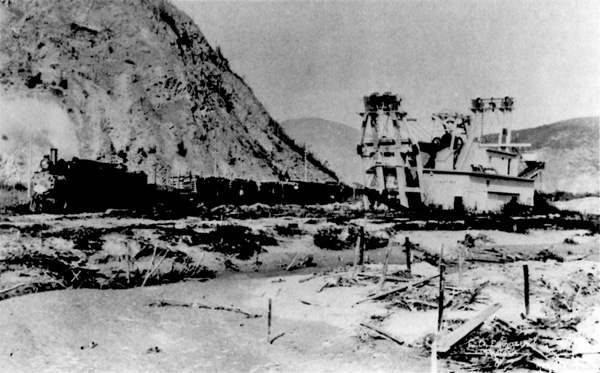
84 A Klondike Mines Railway train and the Yukon Gold Company's
Dredge No. 1. Dredging presaged the end of the railway.
(Public Archives of Canada.)
|

85 A 20-horse team hauls a dredge spud weighing 27 tons
to Bear Creek from Dawson.
(Public Archives of Canada.)
|
The Yukon winter was not as serious an obstacle to road transport as
might be initially suspected. In fact, road conditions were poorest
during the spring and fall with the result that in July 1902 the
territorial council passed an ordinance restricting vehicles to two
horses between 15 April and 31 May, and 15 September and
31 October, and stipulated the use of four-inch tires on heavy
wagons to prevent road damage.70 Hard-packed snow furnished
the Yukon road system with its best surface of the year, facilitating
the movement of people and supplies as well as the principal agents of
motion, horses and dogs. After 1900 a network of "winter trails" was
developed to supplement existing wagon roads. These trails were 75 to 90
per cent cheaper to build than conventional roads, requiring only the
removal of brush and trees, and snow providing the surface.71
They furnished remote communities off the water routes with better
access to Dawson during the winter than at any other time of the year.
The adverse effects of winter on the regular roads occurred during the
spring, when the spring runoff turned roads into virtual swamps,
sometimes causing slides and washouts. It was not until asphalt became
a practical alternative to gravel at a much later date that winter
proved to be a serious deterrent to road rehabilitation and
construction.
Apart from the economic factors that governed policy, the most
serious obstacle to road construction involved the terrain over which
roads were built. The existence of permafrost required techniques of
road construction that were quite different from those that were used
south of the 60th parallel.
Permanently frozen ground, or permafrost as it is commonly called,
lies under a layer of overburden known locally in the Yukon as "muck."
This overburden acts as an insulator, protecting the frozen ground from
the heat of the sun's rays and effectively inhibiting melting. If
removed as a preliminary to the preparation of a roadbed, the permafrost
will melt, causing a softening of the subgrade and making for an
unstable road surface. Fortunately, the economics of road building
between 1900 and 1914 generally precluded any ambitious attempt to
remove the overburden and therefore permafrost did not prove to be a
serious problem. In cases where the overburden was removed inadvertently
or through ignorance, the subgrade could be repaired by re-covering the
exposed permafrost with an artificial overburden of brush and
vegetation. While road builders in the Yukon learned through trial and
error not to tamper with permafrost, those involved in the construction
of the Alaska Highway did not have the benefit of this experience. As we
shall see in a later chapter, one of the major problems encountered
during the construction of the highway derived from a lack of knowledge
concerning the nature of permanently frozen ground.
Along with permafrost, certain soil properties geologically
characteristic of the Yukon added to the already difficult task of road
construction. When available, gravel was used for road surfaces. Gravel
was not always possible to obtain, however, forcing road contractors to
substitute whatever was available, glacial mud,
clay or decomposed schist. None of these alternatives were particularly
satisfactory. Clay and glacial mud were adequate so long as
the road was so drained that water could not combine with them. When it
did, the surface became a quagmire, practically impassable. Decomposed
schist, on the other hand, lacked binding sediment and required constant
grading and maintenance to keep it up.72
Ideally, wagon roads were constructed on a stable earth base covered
with broken stone or gravel, the former being preferred. Once the
surface had been laid, it was graded. Heavy grading required six to
eight horses. If the roadbed were well drained, the road could handle
heavy traffic with minor maintenance. On swampy ground, depressions and
muskeg were corduroyed and covered with earth. This type of road, unlike
the gravel type, required continuous maintenance because the earth
surface deteriorated rapidly under heavy use. Corduroy was also used on
main thoroughfares where gravel was not accessible. Timber for bridges
and culverts was cut from native spruce and lasted for eight to ten
years under stress. Wagon roads varied in cost from $1,500 to $3,300 per
mile, substantially more than the $250 to $350 per mile expended on
winter trails.73
Because of the climate, the terrain and the economics of road
construction, maintaining the territorial road system was as important a
factor in the overland transportation system as the construction of
roads themselves. Roads were poorest in the spring, a result of winter
icing and the spring runoff. To counteract winter icing, road crews cut
and maintained ice trenches during the winter to concentrate the water
and to prevent, so far as was possible, damage to the road. In addition
to this, ice formations or "glaciers," as they were also called, were
cut and the roads were kept plowed. During the spring, maintenance crews
were at their busiest: protecting roads from the spring runoff; removing
snowdrifts, snowslides and other debris from the road surface; opening
up culverts and waterways, sometimes by steam thawing; diverting water
away from roadbeds to prevent washouts, and repairing damage resulting
from water sluicing. Yet despite these preventive and cleanup measures,
the arrival of spring continued to be attended by a general
deterioration of the territorial roads. As one official observed, "the
very conditions which put roads in bad shape will hinder any steps being
taken towards their permanent improvement until such time as the snow is
melted and the ground thawed." During the summer, maintenance crews
repaired ditching, replaced gravel, regraded road surfaces and built up
shoulders and soft spots. Bridge cribbing was ballasted or renewed and
decking was replaced when necessary.74
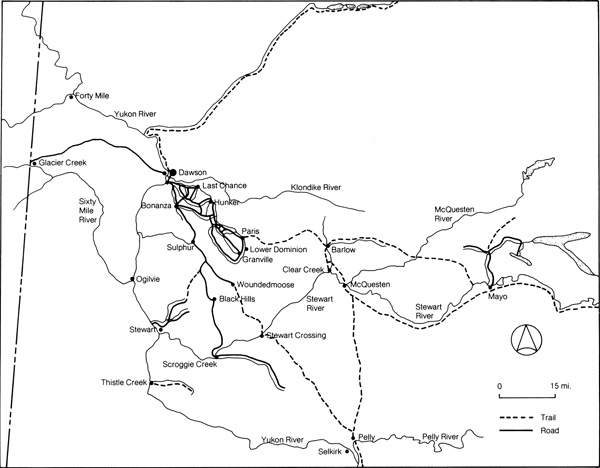
86 Roads and trails in the Klondike and Mayo districts.
(Map by S. Epps.) (click on image for a PDF version)
|
The innovations in mining technology that occurred on a large scale
after 1903 added a new dimension to the maintenance problem. Hitherto,
maintenance crews had concerned themselves almost exclusively with those
problems resulting from the action of natural forces. The effect of
hydraulic monitors and dredges on the contour of the land, however,
exacerbated the already large task involved in maintaining the road
system. Tailings from both operations changed existing drainage systems
and buried roads. Problems of this nature were especially acute on the
Bonanza Creek road where tailings filled water channels, producing
winter icing and spring washouts.75
Between 1900 and 1914 some fourteen hundred miles of road were
constructed in the Yukon Territory. The majority of these roads were
built to give access to groups of working claims and to link small
communities with the closest supply centres. As a general rule they
were built to complement river transportation routes. In only a few
isolated cases were roads constructed for what would now be called
development purposes.76 Geographically, roads were of two
types: intradistrict roads and interdistrict roads. The former were
built within each of the mining districts established by the Mines
Branch of the Department of the Interior (the Dawson or Klondike, Duncan
or Mayo, and Whitehorse districts). These roads had a regional rather
than a territorial significance, their function being determined by the
special requirements of the individual district in which they were
built. The interdistrict roads, on the other hand, were those that
connected one mining district to another.
In terms of mineral production and population density, the Klondike
district was the most important district during this period and it was
there that road and trail construction was concentrated. Before the
Klondike district was provided with an adequate network of roads and
trails, however, a solution to the problem created by Dawson's location
had to be found. Cut off from the centres of mining activity by the
Klondike River to the south and by the Yukon River to the west, Dawson
required substantially improved connections over both before a
satisfactory road programme could be undertaken. The first step toward a
solution to this problem was taken in 1900-01 with the construction
of the Ogilvie Bridge over the Klondike River. The bridge's 155-foot
steel span replaced the cable ferry that had previously carried traffic
across the river. Once completed, road construction proceeded
vigorously. By 1914 the Klondike district was covered with a network of
roads serving the main creeks and their tributaries. Of these, the
principal were the Ogilvie Bridge road, the Bonanza-Indian River road,
the Hunker-Dominion road, the King Solomon Dome-Sulphur road and the
Klondike road. Stages and freighting
outfits operating out of Dawson used these roads to supply the stores
on the creeks and to deliver mail and newspapers to the people who lived
there.77 Between 1906 and 1914 the Klondike Mines Railway
competed with roads contiguous to its right of way, but the economic
difficulties that plagued it and the curtailment of its winter
operations after 1907 resulted in the railway having only a negligible
effect on road transportation in the district as a whole.
Another region for which Dawson acted as a transfer point was the
Sixty Mile mining district, located on the west side of the Yukon
River. Although the gold rush had resulted in a rapid decline in the
importance of this area, prospecting and mining had continued there,
especially on Glacier and Miller creeks. In order to afford improved
communication between Dawson and these creeks, a cable terry was built
across the Yukon River at Dawson in 1902.78
The cable ferry was an ingenious expedient applied to the problem of
crossing rivers in the Yukon where economic circumstances did not
justify the erection of a bridge. Until the end of the Second World War
when roads rapidly superseded water as the primary highways of
transportation, the cable ferry was the most common form of river
crossing in the territory. A relatively simple device, the cable ferry
consisted of a steel cable strung between two towers on each side of the
river. A scow was attached to the cable with a sliding bridle tied to
two cleats, one near each end of the same side of the scow. By adjusting
one side of the bridle with a tightening or a loosening action, the scow
could be angled into the current so it would travel in the desired
direction, the current providing the motive force.79
All traffic moving west of Dawson was taken across the river on the
cable ferry. The scow had a six-horse—one-wagon capacity. When the
cable ferry could not be operated safely — generally at the
beginning or at the close of the navigation season — a canoe was
used instead.80
The erection of the cable ferry resulted in an increase in the volume
of traffic over the river. In 1902 a pack trail that had been cut the
previous year from West Dawson to Glacier was brought up to the standard
of a "passable" wagon road. Increased mining activity in the area over
the next two years was followed by the construction of a good wagon road
in 1904. This new wagon road, in turn, had a salutary effect on mining.
During the winter a sled trail was used to connect Glacier and
Dawson.81
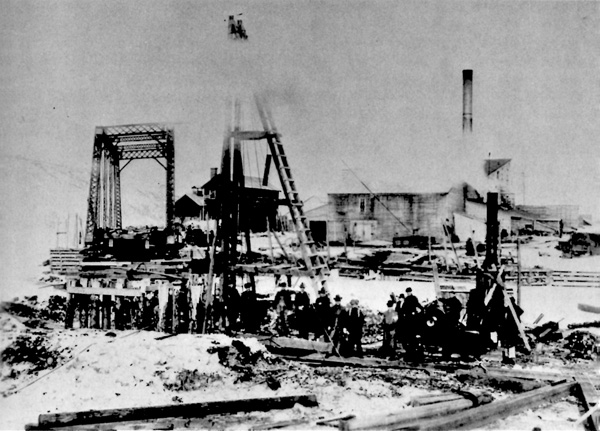
87 The Oglivie Bridge over the Klondike River during construction.
(Public Archives of Canada.)
|
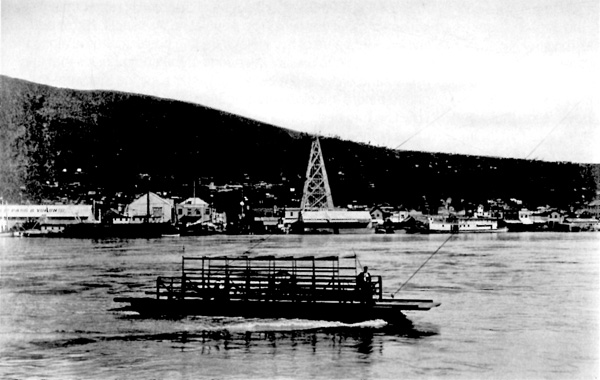
88 The cable ferry linking Dawson with the west bank of the
Yukon River. One end of the cable is attached to the tower.
(Yukon Archives.)
|
Gold was discovered on Duncan Creek in the Mayo district in 1898. The
discovery did not immediately attract many miners, but as the frontier
of mining activity expanded after 1900, some who had failed to locate
profitable claims in the Klondike and some who had already exhausted
their claims there began to trickle into the Mayo area. In 1906 a rich
silver deposit was uncovered on Galena Creek, about five miles west of
Duncan.82 As these discoveries attracted more and more
miners, pressure mounted for the construction of roads to meet the
increasing transportation requirements of the district.
Between 1903 and 1906 the government built roads to connect the town
of Mayo with Duncan Creek, Mayo Lake with Gordon Landing and another
road along Highet Creek. Other roads that were built before 1906 were
built by the inhabitants themselves.83
No overall plan existed whereby Dawson and Mayo were to be connected
by road. Sections of road were built wherever and whenever a need
existed, the need being defined by the requirements of the mining
industry. Despite this rather haphazard approach, a winter road joining
the two centres was completed by 1904. The first link was forged in 1902
with the construction of a winter trail between McQuesten, located at
the confluence of the McQuesten and Stewart rivers, and Gordon Landing.
In 1904 Barlow and McQuesten were joined by a short branch road. In the
same year a winter trail was built along Flat Creek, east of the Barlow
divide, to the Klondike River. The Flat Creek winter trail joined two
sled roads; one on Allgold Creek, the other on Jansen, that ran to
Hunker and Dominion creeks respectively. An alternate route was
completed in 1906-07 when a 58-mile road was built from Mayo to
Clear Creek to connect with a 20-mile stretch of road between Clear
Creek and Barlow that had been built in 1902. Between 1907 and 1914 three
more wagon roads were constructed: the Klondike River-Flat Creek road,
the Jansen Creek-Clear Creek road and the Minto-Galena Creek road.
A number of roads were built in the Whitehorse district between 1901
and 1914. As was the case in the Klondike and Mayo mining districts,
these roads were built to serve the needs of the mining industry. What
distinguished them from those roads that were built in the Klondike and
Mayo districts, however, was that Whitehorse district was the only one
in which the extraction of base metals rivaled that of precious-metal
production.
The first roads to be constructed in the Whitehorse district were to
the copper mines adjacent to the Whitehorse townsite. In 1902, roads
were built to the Grafter and Copper King properties. Rising production
and the discovery of additional deposits after 1902 resulted in the
extension of these roads to the War Eagle and Arctic Chief mines in
1907.
Unlike roads that were built in placer-producing areas where the
preponderant traffic was incoming, the movement of traffic over roads
serving the base-metal mining industry was more balanced, involving
large shipments of outgoing ore. As a result, transportation facilities
had a much more direct bearing on the economics of base-metal mining
than was the the case with the placer type of operation. Not only was
the relation between freight rates and profits more pronounced, but also
roads and vehicles designed to higher standards in order to withstand
heavy use were required. In part it was the failure of the available
transportation facilities to meet these demands — and this includes
the White Pass and Yukon Route spur line to the copper mines as well as
the road system — that resulted in the curtailment and eventual
cessation of copper production.
While the degree of mining activity in the Whitehorse district was
not sufficient to justify road expenditures of the size made in the
Klondike district, several roads were built to facilitate prospecting
and mining. In 1902 a road was built from Mason Landing on the
Hootalinqua River to Livingston Creek. Two years later a wagon road was
built to Kluane Lake from Mile Post 31 on the Overland Trail. During the
next two years roads were built in the Wheaton and Watson River areas
and a short access road was constructed around Windy Arm. Other roads
were built off the Overland Trail between Whitehorse and Dawson, notably
the Thistle Creek road in 1907 and the Coffee Creek-White River trail in
1913. A road was constructed from Whitehorse to Carcross which
complemented the facilities already provided there by the railway. In
1912 a road was built from Carmacks to the Tantalus coal mine.
In the pre-gold-rush period, the annual freeze-up of the Yukon River
had been a source of potential discomfort rather than a cause for great
concern. The population was small, stable and known. Managers of the
various trading posts scattered along the river were able to predict the
needs of the communities that they served and order and receive the
winter supplies that were required before the close of navigation. The
men engaged in prospecting had been genuine pioneers, accepting the fact
that life in the North usually meant belt-tightening in the winter and
perhaps only one mail delivery a year. Before winter drifting was
adopted, many had left for the outside on the last boat, an annual
ritual that alleviated the problem of accumulating provisions for the
winter months.
With the stampede of 1897-98, the supply organizations that had
previously been adequate to the task of winter provisioning proved
totally deficient. No longer were resident trading-post managers able to
predict winter requirements; the incredible influx into Dawson made all
calculation impossible. Furthermore, the stampeders of 1897-98
expected amenities that they had enjoyed in more southern climes and
many of the old-timers, their previous life styles foresaken forever by
the infectious hysteria nurtured by the rush, discovered that they
wanted them as well.

89 Overland Trail.
(Map by S. Epps.) (click on image for a PDF version)
|
In light of these new conditions, a winter link to a supply centre
on the outside was essential. The closest was Skagway and until the
construction of the railroad the only route was over the frozen ice of
the Yukon River by dog team. Apart from the obvious limitations imposed
by the use of dog teams and sleds over a supply line that stretched for
some 500 miles, the Yukon River was closed to all forms of
transportation for two months of the year, in the fall before the river
froze and in the spring when the ice was melting. During these two
months there was no communication with the outside
world.84
In 1899 the Yukon Overland Express and Transportation Company
received a charter from the territorial government to build and operate
a wagon and sleigh road from Bennett Lake to Dawson, complete with
branch roads and relay stations. A primary reason behind the
government's interest in seeing such a road constructed was the need to
materially improve postal service between the territory and the outside.
When the Yukon Overland Express and Transportation Company abandoned
the Bennett Lake-Dawson road project without ever having commenced
construction, the winter mail contract for 1899 was awarded to a man
named Richardson, who assigned it in turn to the Canadian Development
Company. During the winter of 1899-1900 the Canadian Development
Company used dog teams to move mail and light express between Whitehorse
and Dawson, gradually replacing the dogs with horses the following
year. In 1901 the White Pass and Yukon Route bought out the Canadian
Development Company in order to get the mail contract for its
sternwheelers. The movement of mail, an almost totally ignored factor in
northern transportation, was a stable and highly profitable source of
revenue. An indication of its importance is suggested by the name
chosen by the White Pass and Yukon Route to designate its winter sleigh
operation, "The Royal Mail Service," a name that owed far more to
economic realities than might be at first suspected.85 The
acquisition of the Canadian Development Company and the operation of a
winter transportation route between Whitehorse and Dawson was not the
first time the White Pass and Yukon Route had engaged in winter
transportation. Valuable experience had already been gained through the
operation of the "Red Line Transportation Company" between Lindeman and
Bennett lakes during the construction stage of the railway in the winter
of 1899-1900.
In the summer of 1902 the territorial government contracted with the
White Pass and Yukon Route to build a winter road between Whitehorse and
Dawson. Construction began that summer and the road was completed in
November. The company cleared a 12-foot right of way along the entire
distance, graded the surface and built culverts as well as
wood-reinforced earth retaining walls. Considering the topography and
the primitive equipment of the time, building the trail was no easy
task. As W.D. MacBride noted, "this trail was hewn through the
wilderness with axes and crosscut saws, and graded with plows, wheel
scrapers and horses by a small crew of men."86
The "Overland Trail," as the winter road between Whitehorse and
Dawson came to be called, did not follow the Yukon River except during
the spring when melting snow made the trail practically impassable. From
Whitehorse it struck west, crossed the Takhini River, followed the
Little River through Braeburn and went over the divide to the
Nordenskiold through Carmacks. From Mackays, which was later renamed
Yukon Crossing, the trail followed the east bank of the Yukon River to
Pelly, where it crossed the Pelly River. On the north side of the Pelly
it ran northwest to Stewart Crossing and over the Stewart River to
Woundedmoose. From Woundedmoose the trail branched off to the Indian
River and thence to Dawson via Eldorado and Bonanza
creeks.87
On 2 November the first through stage left Whitehorse for Dawson over
the Overland Trail. The road was built at a cost of $129,000 and was 330
miles long, shorter than the river route by some 70 miles.88
Over the years, the location of the road was modified to meet the
changing transportation needs of the territory and to connect new areas
of mining activity with Whitehorse.89
The completion of the Overland Trail marked the end of one era and
the beginning of a new one. Thereafter horses replaced dogs as the
transportation agents between Whitehorse and Dawson, with greatly
improved service between the two centres resulting. For the first time
Dawson was not cut off from the rest of the world for almost eight
months of the year. The winter stage line became, in Laura Berton's
words, "the winter link with civilization" — an important carrier
of people, supplies and mail. For its part, the government, having
expended $129,000 on the undertaking, hoped that the road would "open a
large area of land for cultivation . . . equal in quantity and quality
to any other good farming land."90 Although the Overland
Trail did encourage a few modest attempts at farming, the government's
aspirations in this regard were never realized. Nevertheless, the hope
itself did point up the rather simplistic approach to development which
still prevails to this day: that transportation is the universal panacea
for all of the territory's problems.
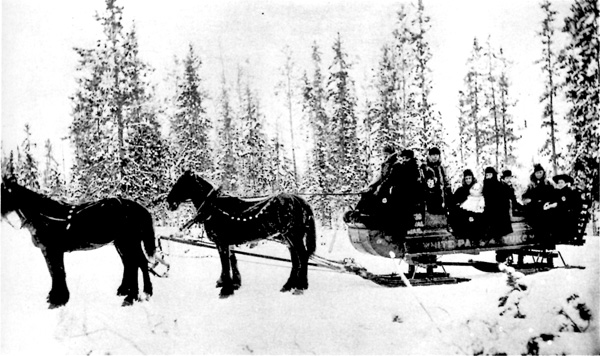
90 A White Pass and Yukon Route Royal Mail sleigh on the
Overland Trail.
(Yukon Archives.)
|
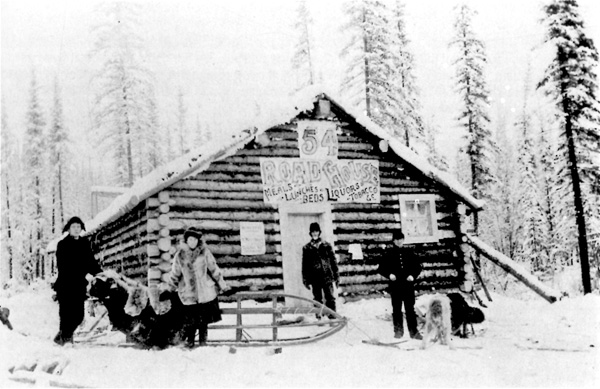
91 A road house on Hunker Creek.
(Yukon Archives.)
|
Between 1902 and 1914 the White Pass and Yukon Route ran tri-weekly
stages and sleighs between Whitehorse and Dawson after the close of
navigation. During the month of March, when traffic density increased
substantially, daily service was often provided. As the closed season of
navigation did not coincide with the winter season, the company used
wheeled stages before the snow was deep enough for sleighs and during
the spring when the ice on the river was melting. Originally the company
had brought in Concord coaches, but their use was discontinued when they
proved ill-suited to trail and climatic conditions. Thereafter the
company constructed its own stages in the Whitehorse workshop. Modelled
on the lines of the Concord coach, these "thoroughbraces," as the
company stages were called, differed from the former in that they were
fitted with layers of leather straps rather than metal leaf springs.
Metal had a tendency to break under sustained use on the rough trail and
was brittle during periods of extreme cold. The leather straps, on the
other hand, proved exceptionally durable and were easier to repair or
replace although they did make for a rougher ride. The thorough-braces
had a 12-passenger capacity and carried up to a ton of baggage, mail and
express in the boot.91
As soon as the snow was deep enough, stages were replaced by sleighs.
The sleighs were drawn by four to six horses and carried up to 14
passengers as well as mail, baggage and express. They were cheaper to
operate than the wheeled stages because snow-covered roads furnished a
much better road surface than non-snow-covered ones. As a result, fares
were cheaper during the winter than during those periods immediately
preceding and following the navigation season.92
Those who travelled the "Royal Mail Service" during the winter wore
raccoon coats and moccasins or felt shoes to keep out the cold. The
company provided "carbon foot warmers" or heated bricks and buffalo
robes.93 In spite of these precautions, many still found it
necessary to indulge liberally in spirits in order to keep warm.
According to Laura Berton,
It was not a comfortable trip. The seats had hardly any backs and
we had not been out long before I became unpleasantly conscious of my
neck. It just wouldn't hold up my wobbling head. With no support from
the seat I tried tying a scarf over my turban, binding it tightly around
my head. It was no use.94
The trip between Whitehorse and Dawson took anywhere from three
to ten days, five days being the average. Three to four posts, spaced at
20-mile intervals, were made in a single day depending on the weather
and the trail conditions. At each post the passengers ate and rested
while fresh horses were harnessed to the sleigh for the next 20-mile
section. Each post generally consisted of a complex of buildings: a
roadhouse, stables, storehouses, cabins and wood piles.95 A
typical roadhouse on the Overland Trail was described by Mrs.
Berton:
In one general room stood the familiar giant heater around which
was built an iron rack on which we hung our wet gauntlets, scarves and
coats. Beside this was a long table absolutely jammed with hot food
— roast moose, caribou, mountain sheep, native-blueberry pie and
huge dishes of baked beans. As I was travelling alone I was allotted a
tiny cubicle with a bed to myself. The single men slept in bunks, which
in the smaller posts were all in the main room.96
Roadhouses were an important factor in winter transportation,
not only on the Overland Trail but on other territorial roads as
well.97 They were especially vital for the interdistrict road
system, where travel over long distances and in climatic extremes
required frequent stops. But while roadhouses were havens to each
traveller for the food, rest and warmth they offered, they were also
firetraps. In 1907 the territorial council acted on the ever-present
fire threat by passing an ordinance requiring roadhouses of more than
one storey to be equipped with fire escapes. Wherever this regulation
was obeyed, it was adhered to in typical frontier fashion: a rope was
hung from an open window.98
The Overland Trail was not a single uninterrupted stretch of road,
but actually five sections of road divided by four rivers: the Takhini,
the Yukon, the Pelly and the Stewart. Before these rivers froze, stages
were run to the river crossings where passengers, mail and baggage were
transferred by canoe to a stage waiting on the other side. During the
winter, river crossings were not a problem as the sleighs crossed over
the frozen surface of the river on ice bridges.99 Ice
bridges, like the cable ferries that were used during the season of open
navigation, were the solution applied to the problem of connecting roads
separated by water in the Yukon.
In all, about two hundred horses were employed by the Royal Mail
Service on the Overland Trail during the winter season. The White Pass
and Yukon Route maintained facilities at Whitehorse for the treatment of
horses and retained the services of a veterinarian. During the summer
when the horses were not working, they were put out to pasture where
they grazed on native grass. In the winter they were fed on bran mash,
oats and timothy hay brought in from the West Coast. The horses grew
long hair as a protection against the cold, but before returning to work
each fall the upper parts of their bodies were clipped to prevent
steaming. To prevent their lungs from being "burned," a fatal condition
produced by breathing in cold air, protectors were placed over their
chests and a bag-like contraption was placed over their nostrils.
Summer care was minimal, limited to "painting" the horses with a
concoction of tar and oil in order to repel insects.100
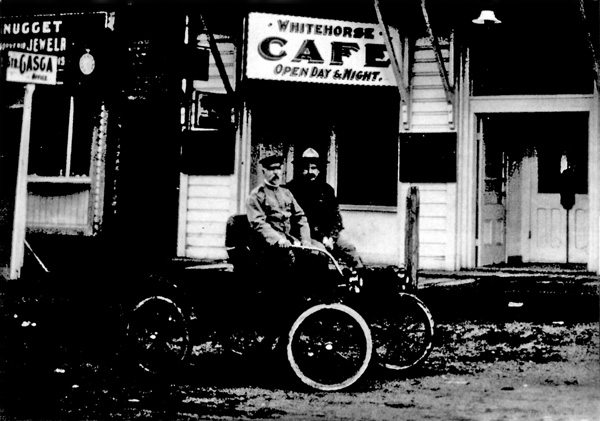
92 One of Whitehorse's first automobiles, 1903.
(Yukon Archives.)
|
According to H.J. Woodside, editor of the Yukon Sun, there
were three automobiles in the Dawson area by September 1901.101
The automobile remained something of a novelty for the next ten years,
however, owing to the primitive state of the territorial road system.
The existence of a much cheaper form of transportation in the
sternwheeler, moreover, acted to delay the conversion to automobile
and truck transport on a large scale until the 1940s. Nevertheless, the
pressure toward conversion increased gradually after 1912.
In 1912 a car was driven over the Overland Trail for the first time.
This was followed by a petition to the federal government for an
appropriation to improve the Whitehorse-Dawson road for motor traffic.
Two years later the use of cars and trucks had become common enough to
require the regulation of vehicle speed over the Overland Trail and in
the city of Dawson. During 1914-15 expenditures were made to
improve the Overland Trail. At the same time, substantial improvements
were made to the river crossings on the Yukon, Pelly and Stewart rivers
by the erection of cable ferries. In order to eliminate the canoe
transfers used during freeze-up and break-up, the White Pass and Yukon
Route developed the technique of booming the river above each ferry to
jam the ice. As soon as the ice above the ferry had frozen, the cable
ferries were removed and traffic crossed over the ice formed by the
boom. As a result of these improvements, traffic movement was greatly
facilitated between Whitehorse and Dawson.102 Nevertheless,
traffic movement continued to be dominated almost exclusively by
horse-drawn sleighs.
As we have seen, road expenditures were paid for out of public funds.
An informal cost-sharing plan between the territorial and federal
governments existed whereby the latter contributed approximately 55 to
60 per cent of all moneys needed for construction. After 1900, when
political activity replaced drinking and gambling as the main avocation
of the territorial citizenry, road construction and maintenance became a
political issue and a primary form of patronage.103
Roads, especially in the Klondike district, had a significant effect
on the territorial economy. As early as 1900 the commissioner was able
to report that road construction "paid for itself indirectly by reduced
costs transport."104 This reduction was a powerful stimulus
to the territorial economy, coming as it did after the collapse of the
gold-rush boom. In the mining industry, roads reduced the costs of
extraction to such an extent "that low grade ground which in the early
years of this country was not considered of any value is being worked at
a profit." The road system played an important role in the conversion to
machine-oriented mining, as did other contemporary forms of
transportation, by furnishing the necessary conditions for the movement
of heavy traffic over land and by so reducing transportation costs that
the large-scale importation of dredges was economically feasible. The
network of roads that emerged during this period also increased the
mobility of the mining population by enabling prospectors to transfer
their operations to new locations as old deposits were exhausted and as
machinery superseded individual enterprise.105
Roads, again in the Klondike district, assisted the growth of a
number of communities on the gold-bearing creeks. As a result,
transportation movement between Dawson and the creeks decreased as roads
made it possible for the miners to purchase their supplies on the creeks
rather than having to make the trip into Dawson.106 The
decline in Dawson's status as the retail centre of the district was
intensified after 1902 when Dawson received its municipal charter.
Incorporation brought increased taxation as municipal status was
accompanied by the responsibility for municipal services and many
merchants and entrepreneurs, already suffering the effects of economic
contraction, took advantage of better road communication between Dawson
and the creeks to move their operations outside the city. But even on
the creeks the merchants were not immune to the effects of a continually
improving road system and after 1906 the creek stores "suffered from the
competition of peddlars who took advantage of improved roads to dispose
of goods, delivered at the cabins at prices slightly higher than Dawson
prices."107
While the mining industry was the main beneficiary of better roads,
other segments of the economy experienced the stimulating effects of
improved highway communication. As the commissioner noted in 1902. "when
a road is started or there is a prospect of a new road being built,
applications immediately begin to pour into this office for agricultural
land at the terminals of such roads."108 The increase in road
transport created the need for more horses and with them, more hay, the
main agricultural enterprise of the territory. Roads also assisted the
timber industry by providing better access to timber stands as the old
ones were depleted.

93 The first motor trip over the Overland Trail, Dawson to
Whitehorse, made in December 1912.
(Public Archives of Canada.)
|
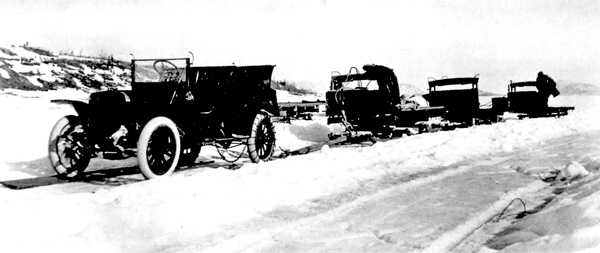
94 The automobile did not replace the horse as a means of
hauling freight on the Overland Trail; however, by 1912,
Yukoners recognized the possibilities of the internal
combustion engine.
(Yukon Archives.)
|
The importance of roads, however, was not limited to their effects,
individual and cumulative, on the territorial economy. The building of
roads marked a significant departure from the previous transportation
preoccupation — communication with the outside. After 1900 great
energy was expended on an internal transportation system of which roads
formed the most important single element. For the first time a tension
arose, setting the need for better communication links with the outside
against the need for improved transportation services within the
territory itself. Local needs were transposed into local demands for domestic
transportation, demands that were often at odds with the Yukon's transportation
requirements as seen by the large mining and trading companies and
Ottawa bureaucrats. The local population, moreover, generally defined
their needs in terms of roads. As the years passed this tension was to
become more acute. Like much of the territory's political history, the
history of transportation in the Yukon was not without its underlying
theme of colonial-imperial conflict.
VII
The introduction of capital-intensive mining dominated by a few large
companies during the first decade of the 20th century constituted a
revolution in the economic organization of mining that has prevailed to
the present day. At the same time the transportation industry, which
played an integral part in this economic transformation, displayed a
similar propensity toward consolidation. When the plethora of
transportation companies that had sprung up during the great stampede
abandoned the field after the collapse of the gold-rush economy, one
company, the White Pass and Yukon Route, became dominant, so dominant in
fact that except for local overland transport and water transport on the
economically marginal tributary streams, the White Pass and Yukon Route
had become practically synonymous with Yukon transportation by
1914.
|

